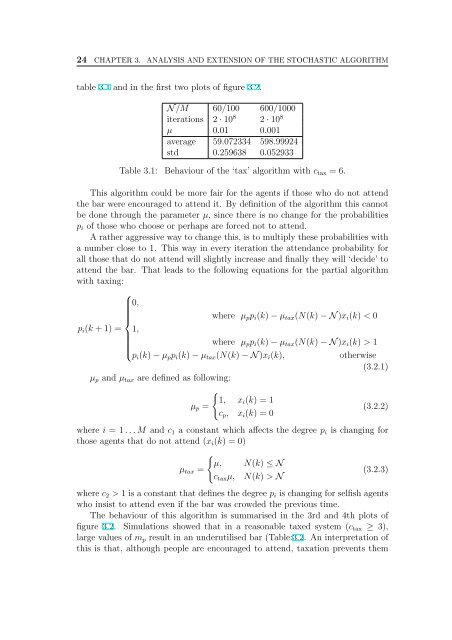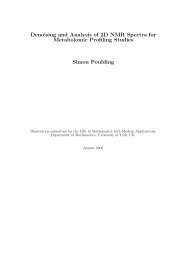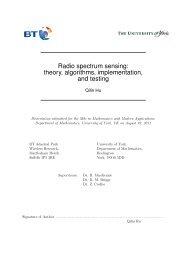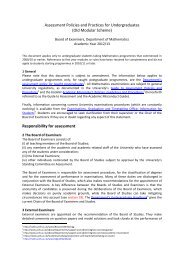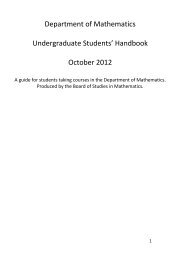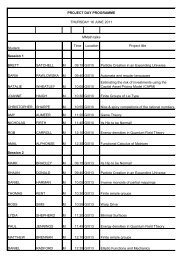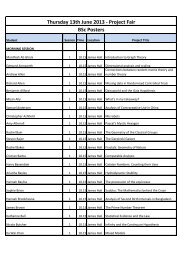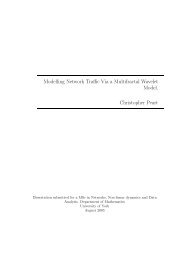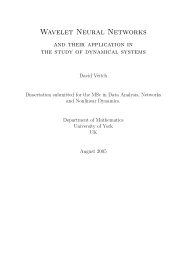The El Farol Bar Problem for next generation systems
The El Farol Bar Problem for next generation systems
The El Farol Bar Problem for next generation systems
You also want an ePaper? Increase the reach of your titles
YUMPU automatically turns print PDFs into web optimized ePapers that Google loves.
24 CHAPTER 3. ANALYSIS AND EXTENSION OF THE STOCHASTIC ALGORITHM<br />
table 3.1 and in the first two plots of figure 3.2.<br />
N /M 60/100 600/1000<br />
iterations 2 · 10 8 2 · 10 8<br />
µ 0.01 0.001<br />
average 59.072334 598.99924<br />
std 0.259638 0.052933<br />
Table 3.1: Behaviour of the ‘tax’ algorithm with ctax = 6.<br />
This algorithm could be more fair <strong>for</strong> the agents if those who do not attend<br />
the bar were encouraged to attend it. By definition of the algorithm this cannot<br />
be done through the parameter µ, since there is no change <strong>for</strong> the probabilities<br />
pi of those who choose or perhaps are <strong>for</strong>ced not to attend.<br />
A rather aggressive way to change this, is to multiply these probabilities with<br />
a number close to 1. This way in every iteration the attendance probability <strong>for</strong><br />
all those that do not attend will slightly increase and finally they will ‘decide’ to<br />
attend the bar. That leads to the following equations <strong>for</strong> the partial algorithm<br />
with taxing:<br />
⎧<br />
0,<br />
⎪⎨<br />
where µppi(k) − µtax(N(k) − N )xi(k) < 0<br />
pi(k + 1) = 1,<br />
where µppi(k) − µtax(N(k) − N )xi(k) > 1<br />
⎪⎩<br />
pi(k) − µppi(k) − µtax(N(k) − N )xi(k), otherwise<br />
(3.2.1)<br />
µp and µtax are defined as following:<br />
<br />
1, xi(k) = 1<br />
µp =<br />
(3.2.2)<br />
cp, xi(k) = 0<br />
where i = 1 . . . M and c1 a constant which affects the degree pi is changing <strong>for</strong><br />
those agents that do not attend (xi(k) = 0)<br />
<br />
µ, N(k) ≤ N<br />
µtax =<br />
(3.2.3)<br />
ctaxµ, N(k) > N<br />
where c2 > 1 is a constant that defines the degree pi is changing <strong>for</strong> selfish agents<br />
who insist to attend even if the bar was crowded the previous time.<br />
<strong>The</strong> behaviour of this algorithm is summarised in the 3rd and 4th plots of<br />
figure 3.2. Simulations showed that in a reasonable taxed system (ctax ≥ 3),<br />
large values of mp result in an underutilised bar (Table:3.2. An interpretation of<br />
this is that, although people are encouraged to attend, taxation prevents them


